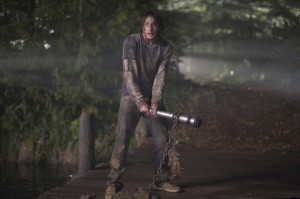 [This post contains spoilers for The Cabin In The Woods which is the best movie of 2012 (so far) and would be utterly ruined by you reading this piece. Please Instapaper this page, go watch the movie, then come back and read. I don’t usually care about spoiling things for myself or others because I think consuming any piece of media is more about the journey than the destination, but this is the only movie I’ve seen in a long time that I really believe knowing what will happen will spoil your experience of watching it, in the pre-internet definition of the word “spoil.”]
[This post contains spoilers for The Cabin In The Woods which is the best movie of 2012 (so far) and would be utterly ruined by you reading this piece. Please Instapaper this page, go watch the movie, then come back and read. I don’t usually care about spoiling things for myself or others because I think consuming any piece of media is more about the journey than the destination, but this is the only movie I’ve seen in a long time that I really believe knowing what will happen will spoil your experience of watching it, in the pre-internet definition of the word “spoil.”]
In a masterful a masterful takedown of the trend piece genre published on this site, Zachary Howe makes a point that I would like to revisit:
The problem with articles that claim the downfall of culture is that they believe people are watching reality TV instead of attending Mozart concerts — that they are consuming today’s “low culture” instead of today’s “high culture” — when in fact they are watching reality TV instead of reading silly novels by lady novelists; they are consuming today’s “low culture” instead of yesterday’s. The answer is not to eradicate pop culture, but rather to encourage a healthy consumption of it. It’s about integration, not exclusion.
I’m not entirely sure why Howe put quotation marks around the phrases “high culture” and “low culture,” but here’s hoping he did so in order to call into question the very concept of high brow culture in opposition to low brow culture.
The idea that some parts of culture being good for you to consume and some parts of the culture being bad for you to consume is incredibly flawed: it is not only useless for evaluating worth, but it creates problematic conversations that are less interesting and, more often than not, besides the point. For example, is it more worthwhile to argue that Keeping Up With The Kardashians is low brow and Kim Kardashian is famous for doing nothing, than it is to try to parse out why something like Keeping Up With The Kardashians resonated with so many people and Kim Karsashian became so famous? I’d rather talk about the latter.
Contempt for the articles that claim the downfall of culture shouldn’t just exist because the authors of those articles assume people are consuming “low brow culture” instead of “high brow culture;” the contempt should be for the reaffirmation that shoving culture into a brow system is flawed in and of itself. Whether you’re calling opera high art or Jersey Shore low art, you’re upholding a system that is broken, was broken from the beginning. Make a list of all the books that you consider, or you think other people or people in some kind of vague authoritative position consider, the “canon.” Now count how many authors on the list are women or people of color. Like, two of each, right? If we’re lucky?
The division between high brow and low brow is starting to break down for a number of reasons (the internet, changing cultural values, etc.) but most people still feel the need to hold onto traces of it, relegating certain media objects to “guilty pleasure” status or talking about how something is “so bad it’s good.” Calling The Voice or 50 Shades of Grey a guilty pleasure is a cop-out; it’s a way to consume and enjoy something, and publicly talk about consuming and enjoying that thing, while simultaneously distancing yourself from that thing, refusing to claim it, refusing to let others consider it a part of your stable of cultural objects identified with you. It makes sense to do this with something you’re ashamed of liking in a world when we define our identities by the things we publicly like, but it also makes you something like the popular kid in high school who has a secret nerd girlfriend or boyfriend who you won’t talk to during class in case any of the other cool kids see you together.
The movie The Cabin in the Woods attacks this behavior dead on. It is both a horror movie and a movie about the people who make and watch horror movies. The Cabin in the Woods is only half about the cabin in the woods and the kids who fuck and drink and smoke pot and die there. The other half of the movie is about the people who make the cabin and watch the kids die. The thematic subtext (or supertext) is all about examining the reasons why people who like horror movies like horror movies. It puts up a mirror and forces the audience to look in it, while simultaneously shouting the questions: “Why do you like this? Why do you want to see this hot girl’s boobs and then see her torn apart by redneck zombies to punish her for showing her boobs? Why are you getting off on all this pain and suffering?!”
The Cabin in the Woods doesn’t let you pretend you’re watching because B horror movies are “so bad they are good;” it doesn’t let you call something low-brow so you can wash your hands of it. The movie wants to force you to actually engage with the reasons you like this kind of thing, as you should.
This post may contain affiliate links.








